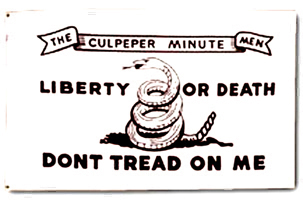|
The History Of The 13th Virginia Infantry
Flag.
Like most Confederate Units ,The 13th needed a way to distinguish
itself on the battlefield. Thay used the battle cross, based on the Saint Andrews Cross, it was adopted by many Confederate
units after the First Battle Of Manassas, and later was incorporated into both the second and third national flags of the
Confederacy.The flag of the 13th Virginia was sewn by the wife of the 13th's first Colonel, A.P. Hill.
Mrs. Kitty Morgan Hill was
a native of Kentucky. Because Kentucky was a boader state, it did not secede from the Union. As a result, Mrs. Hill chose
not to include the center star on to the flag of the 13th virginia. The center star is present on many of the Confederate
Battle Flags to represent the soldiers from Kentucky who did serve the South in the war.

The Culpeper Minutemen was a militia group formed in 1775 in the district around Culpeper, Virginia. Like minutemen in other British colonies, the men drilled in military tactics and trained to respond to emergencies "at a minute's notice."
The Culpeper minutemen fought for the patriot side in the first year of the American Revolution, and are remembered for their company flag: a white banner featuring a rattlesnake, featuring the phrases "Liberty or Death" and "Don't Tread on Me". At the time, Culpeper was considered frontier territory, and the Culpeper minutemen, many of them
hunters, preferred the rifle to the musket.
In October 1775, the minutemen were sent to Hampton in response to British ships attempting to land. The riflemen were able to effectively shoot the men manning the ships cannons,
and the fleet eventually sailed away.
The Culpeper militia next participated in the Battle of Great Bridge in December 1775. The battle was a complete American victory. There were accounts of the battle that suggested the British
were unnerved by the reputation of the frontiersmen.
The Culpeper Minutemen disbanded in January 1776 under orders from the Committee of Safety. Many of the minutemen continued
to serve. Some joined the continental line, and others fought under Daniel Morgan.
John Marshall, the fourth Chief Justice of the United States, was a member of the original Culpeper Minutemen.
In 1860, the Culpeper Minutemen were formed under the same oak tree where the 1775 Minutemen had organized. They also carried the
same rattlesnake flag. The unit was mustered into the Confederate 13th Infantry and fought in several battles.
The Culpeper Minutemen were again organized for World War I, and joined the 116th Infantry
Though flags similar to Virginia's current flag had flown in the State since
the 1830s, Virginia did not adopt an official flag until after it had seceded from the Union in 1861. The Flag of the Commonwealth
was adopted on April 30, 1861 almost two weeks after Virginia voted, on April 17, 1861, to repeal its 1788 ratification of
the Constitution of the United States. The Virginia Flag of the Commonwealth displays the State Seal of Virginia centered on a blue field (background).Be it ordained by the convention of the commonwealth of Virginia, that the flag of this commonwealth shall hereafter
be made of bunting, which shall be a deep blue field with a circle of white in the center, upon which shall be painted or
embroidered, to show on both sides alike, the coat of arms of the state, as described by the convention. "Virtus, the genius of the commonwealth, dressed like an Amazon, resting on a spear with one
hand, and holding a sword in other, and treading on tyranny, represented by a man prostrate, a crown fallen from his head,
a broken chain in his left hand and a scourge in his right. In the exergon the word Virginia over the head of Virtus, and
underneath the words "Sic Semper Tyrannis."
This flag shall be known and respected as the flag of Virginia.
The governor shall regulate the size and dimensions of the flag proper for forts, arsenals
and public buildings, for ships of war and merchant marine, for troops in the field, respectively, and for any other purpose,
according to his discretion; which regulations shall be published and proclaimed by him as occasion may require.
Next Page
|

